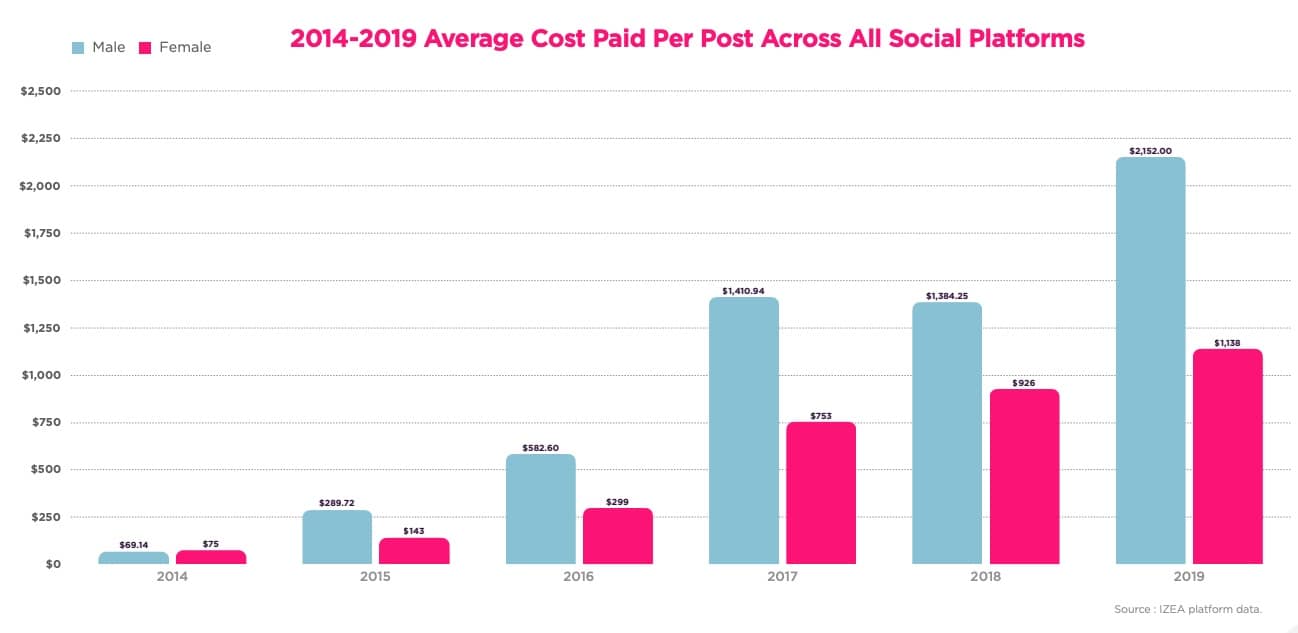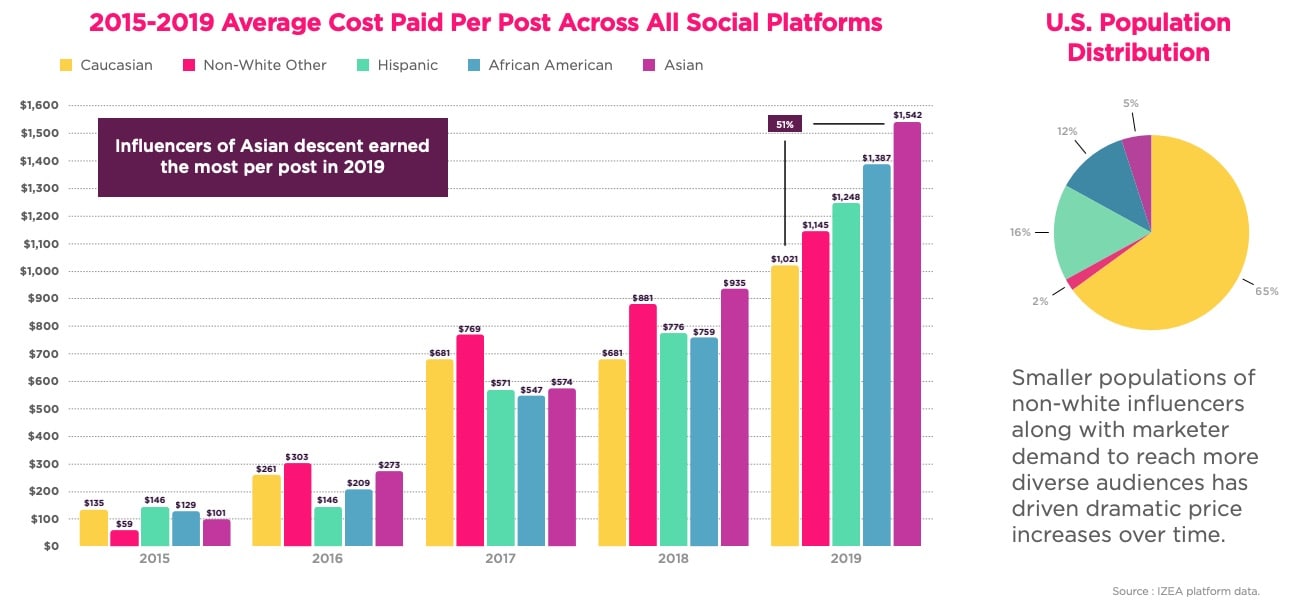There exists a gender gap in influencer marketing. At least that’s what a pair of published reports indicate. Forbes contributor Heather Leighton asked for my take on new HypeAuditor data last week that indicated male influencers earn seven percent more than their female counterparts. You can see her story and my take at Forbes.
Today, IZEA released a more in-depth data set on equality in the influencer marketing industry that not only validates a gender pay gap, but illustrates a far greater one than just seven percent. According to the newly minted IZEA report “The State of Influencer Equality” the average male influencer takes in $2,152 per post across all platforms. The average female? $1,138. That’s a difference of 48 percent.
Male influencers make almost twice what female influencers make.

There are a few different ways to react to this and the right way is probably some compromise of the two. You can say, “Brands are discriminatory against women in how they pay for influencer marketing.” But if you’ve ever worked with influencers on the brand side — or are an influencer yourself — you know that the influencer dictates pricing. So the other way to react is, “Female influencers are severely undervaluing their work.”
It could be that men have more of a supply vs. demand advantage and can charge more and the opposite is true for women. There are far more women influencers in IZEA’s data set. They account for 87 percent of all deals factored into the data. Women are in greater supply, so in verticals where gender matters, brands can pay less because there are just more options, driving prices down.
That’s where IZEA Ted Murphy landed. His quote in the press release that accompanied the data read like this:
“We believe this gap is largely due to the abundance of brand-friendly female influencers. Influencer marketing started with ‘mommy bloggers’ more than a decade ago, and females still dominate the landscape today. However, the sheer volume of female influencers vying for brand dollars reduces their pricing leverage compared to their male counterparts.”
Do brands pay less intentionally? I don’t think they do in sinister or overt ways, but the fact the market conditions exist to enable the disparity is concerning.
Are women undervaluing their content or contributions to a brand’s efforts? It’s hard to say. Maybe men are overvaluing theirs? But the gap, which closed a bit in 2018 to 33 percent, has now jumped back up too close to half.
What do we do?
The influencer marketplace is one without a lot of regulation or constraint. And since almost all influencers are contract labor, it will continue to be an open market. If one influencer convinces a brand their post is worth $2,500 and a similar convinces them to pay $1,250 for the same type of deliverables, then one is better than the other at communicating perceived value.
Unfortunately, the market conditions and current data show us that men appear to be better at this or that the supply and demand issue has a far larger impact on the bottom line of costs than one might think.
The good news is that the solution lies in understanding the problem. There’s no one thing that will fix the influencer gender pay gap. Female influencers need to understand what their male counterparts charge and value their content and contributions accordingly. More men need to become influencers, thus making that side of the gender aisle more competitive and mitigating increased prices.
And yes, brands can play a role, too. Look at your influencer costs per post and simply insist on being fair.
If we don’t all work to make the numbers more aligned, then this wonderful world lacking in regulation and standards will somehow evolve to being overly managed by bureaucracies we won’t care for. Let’s all work to clean it up, shall we?
The Race Card looks very different
Perhaps on the positive side of the equity aisle, according to IZEA’s report, white folks are actually paid LESS on the dollar than people of color. The average charge per post in 2019 for caucasians was $1,021. Those of Asian decent earned more than $500 more while African-Americans pulled in over $350 more. Hispanics beat Caucasians by over $220 per post. The Non-White Other category beat them by $124.

I really think this solidifies my theory that the law of supply and demand is dictating the differences. Caucasians make up 65 percent of the market with Hispanics (16%), African-Americans (12%) and Asians (5%) coming in much smaller segments. This generally aligns with the thought that supply and demand is driving the gaps. The more unique (smaller audience, thus lower supply and higher demand).
This leaves us in a weird place in terms of reconciliation, doesn’t it? You can’t say, “Good for the minorities! They finally have an advantage!” and not also be happy that men are finding just desserts. Of course, that just might be my meager brain trying to comprehend it all.
I’m sure someone will be offended by that. I don’t mean any disrespect to anyone. I find it curious. Sue me.
The Market benefits the young
IZEA’s numbers also show that influencers 17 and under almost double the per post take of any other comparative age group. Youth take in $850 per post compared to $534 for those 18-24 and $371 for those 25-34. It continues to decline by 10-year segments until beyond middle age. The 55-64 segment makes $192 per post, up eight bucks from their slightly younger counterparts. The 65+ crowd jumps up to $289 per post.
Less youngsters and less seniors, plus more influencers in the 35-64 range might align with my supply and demand theory. IZEA didn’t give us a marketshare break down of age groups.
What to make of it all
Having the data alone is a huge advantage for all of us. Big props to Ted Murphy and the IZEA team for tracking these numbers and sharing them. Knowing there exists a problem is half the battle. Figuring out what to do about it the other.
I think we need to move forward with the idea of trying to even out the gaps but understanding the open market nature that comes with lack of regulation means it’s often going to be a buyer’s market. Brands should try to pay fairly across genders, races and age groups. But we have to account for the fact that a rare find — statistically speaking, that would include, say, a 65+ hispanic male influencer — might demand a higher pay grade than some other groups.
You can see more charts and graphs over at IZEA now.

